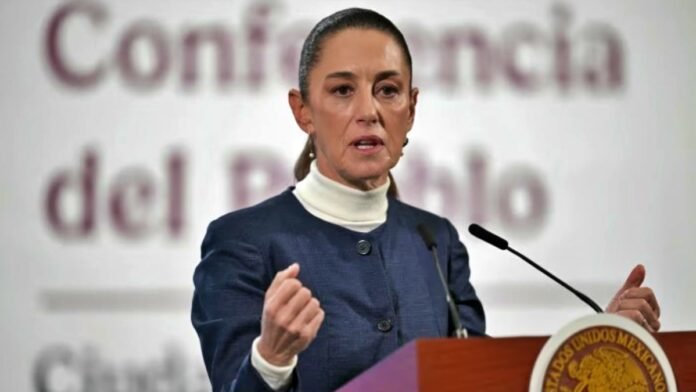
Key Points:
- Mexico threatens legal action against Google for renaming the Gulf of Mexico to “Gulf of America” on its platform for U.S. users.
- The renaming follows an executive order by U.S. President Donald Trump, sparking international backlash.
- Mexican President Claudia Sheinbaum emphasizes the move violates international agreements and Mexico’s sovereignty.
- The Gulf remains officially recognized as the Gulf of Mexico by international organizations and most countries.
Mexico City: The Mexican government has issued a stern warning to Google, threatening legal action if the tech giant continues to display the Gulf of Mexico as the “Gulf of America” on its platform for U.S. users. This controversy stems from an executive order signed by U.S. President Donald Trump, which officially renamed the body of water to “Gulf of America” within U.S. territorial waters.
Mexican President Claudia Sheinbaum addressed the issue during a press conference at the National Palace on Monday, stating, “We will wait for a response from Google, and if there is no response, we will take legal action. They have no authority. Google does not have the right to change the name of this platform for Mexico and Cuba.”
Sheinbaum further clarified that Trump’s executive order applies only to U.S. territorial waters—up to 22 nautical miles from its coast—and does not extend to areas controlled by Mexico or Cuba. “The executive order renames only the continental shelf under U.S. jurisdiction, not the entire Gulf,” she asserted.
Trump’s Controversial Executive Order
On January 20, 2025, his first day in office after re-election, President Donald Trump signed Executive Order 14172 titled “Restoring Names That Honor American Greatness.” The order directed federal agencies to rename the Gulf of Mexico as the “Gulf of America” within U.S. territorial waters and on official government documents.
Trump justified the decision by emphasizing the Gulf’s economic and strategic importance to the United States. He declared February 9 as “Gulf of America Day” and proclaimed that the renaming would “restore American pride” and highlight the nation’s historical achievements.
The U.S. Coast Guard and Department of Interior have already implemented the name change on federal maps and websites, while Google followed suit for users accessing its Maps service within U.S. borders.
Mexico’s Response: Defending Sovereignty
Mexico has strongly opposed Trump’s unilateral decision, arguing that it undermines international agreements and disrespects its territorial rights over significant portions of the Gulf. In a formal letter to Google, Mexican officials demanded that if any name change is made visible on their platforms, it should reflect “América Mexicana” instead of “Gulf of America.”
Citing provisions from the United Nations Convention on the Law of the Sea (UNCLOS), Mexico highlighted that no single nation has exclusive ownership over the Gulf, which borders three countries—Mexico, Cuba, and the United States. The convention grants each country rights over its respective territorial waters and exclusive economic zones (EEZ), extending up to 200 nautical miles offshore.
Cuba has yet to formally comment on whether it recognizes Trump’s renaming directive but shares similar territorial rights over parts of the Gulf.
International Backlash Against Renaming
The renaming has sparked criticism from several countries and international organizations:
- United Kingdom: Officials have stated they will continue referring to it as “Gulf of Mexico.”
- European Union: Italy and France have dismissed any recognition of “Gulf of America.”
- Latin America: Nations like Brazil and Argentina have expressed solidarity with Mexico in opposing unilateral changes to internationally recognized names.
Even within the United States, critics argue that Trump’s decision is symbolic rather than practical. Legal experts have pointed out that while federal agencies can adopt such changes domestically, they hold no weight internationally.
Google’s Role in Controversy
Google’s compliance with Trump’s directive has drawn sharp criticism from Mexican authorities. The tech company updated its Maps service for users in the United States to display “Gulf of America,” but retained “Gulf of Mexico” for users in other countries.
President Sheinbaum accused Google of overstepping its bounds by applying changes beyond U.S. jurisdiction: “Google is renaming Mexican and Cuban platforms without consent. We do not agree with that.”
While Google has yet to issue an official statement, sources indicate that discussions are ongoing between company representatives and Mexican officials.
What Lies Ahead?
As tensions escalate, Mexico appears determined to defend its sovereignty over one of its most iconic geographic landmarks. Legal experts suggest that if Google fails to address Mexico’s concerns, a lawsuit could be filed in international courts under UNCLOS provisions.
This dispute underscores broader geopolitical tensions between Mexico and Trump’s administration, which have already clashed over trade tariffs, immigration policies, and now territorial nomenclature.
For now, both nations remain at odds over what may seem like a symbolic issue but carries significant implications for national pride and international diplomacy. Whether this standoff will lead to resolution or further escalation remains uncertain.

















































